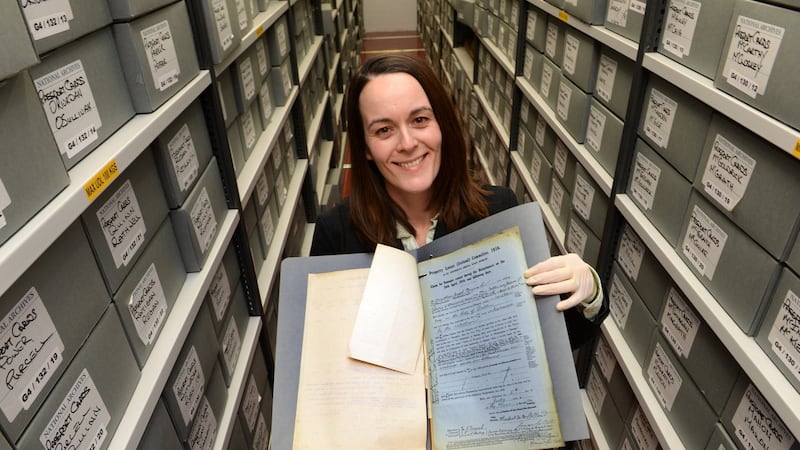While the 1916 Rising may have precipitated Ireland’s freedom from British rule it also spawned one of the biggest mass-compensation claims in the country’s history. Details of the claims have come to light and reveal, in fascinating detail, the art, antiques, jewels and clothing that was either destroyed or looted in Dublin.
The National Archives of Ireland has launched a new website detailing more than 6,500 compensation claims which were submitted to a committee established by the British authorities in the aftermath of the Rising.
While most of the claims relate to damaged business and homes in Dublin, new light is also shed on personal effects that were lost. Archivist Niamh McDonnell, who managed the huge task of digitising the files, said the website will enable researchers and historians to “fill in gaps in knowledge and to gain a greater understanding of the social, economic and architectural fallout of the Rising”.

One of the buildings destroyed was Academy House on Lower Abbey Street – a purpose-built facility that was home to the Royal Hibernian Academy. The art organisation was holding its annual exhibition at the time of the Rising when the building went on fire. Over five hundred works of art were on display, all of which were destroyed, along with the Academy's holdings of fine art prints, books, and other materials.
Instead of offering up their art as a sacrifice to the struggle for Independence, the artists – like everyone else – were quick to claim compensation from the Property Losses (Ireland) Committee.
Well-known artists
Among the well-known artists who claimed were: J Humber Craig of Bangor, Co Down, who claimed £27. 7s [shillings] for two paintings – the committee recommended that he get £15.4s; William John Leech of Kensington, London, who claimed £68.5s for three paintings but was awarded £44.4s; Sarah Purser of Mespil House, Dublin, who claimed £270 for seven paintings and was awarded £201.9s; and Leo Whelan of Eccles Street, Dublin, who claimed £66 for two paintings and was awarded £29.15s.
Also among the claimants is Jack B Yeats of Red Ford House, Greystones, Co Wicklow, who claimed £47.5s for three three oil paintings named as The Donkey Show, The Turning Post in the Tide and The Runaway but was awarded only £26.7s. The correspondence shows that Yeats contested the settlement and wrote to "formally protest against any reduction in the amount". The committee, however, rejected his complaint.
Most of the artists who submitted claims were not then – and never became – famous. Among them was Archibald McGoogan of Ardenza Terrace in Monkstown, Dublin, who wanted £43.18s for three paintings destroyed – including Haymaking near Glendalough. The committee seemed to believe the artist overvalued himself and offered him less than one-third – £12.15s. Unlike Yeats, he seems to have taken it on the chin.
One of the biggest claims was submitted not by an artist but by a collector – one George Sydney Waterlow of The Grove, Killiney, Co Dublin, who had had the misfortune of having loaned his art collection to the RHA. He claimed for 19 paintings worth £2,100.12s. He was awarded just over half that figure – £1,123 pounds. He complained bitterly, claiming that just one of the paintings was worth 1,000 pounds and he had turned down an offer of £840 for it from Christie's in London.The committee gave no ground in this instance either, however.
The most famous artist to claim was John Lavery – later became Sir John Lavery – of 5 Cromwell Place, London who claimed £600 for a painting titled Girls in Sunlight. He received £425.
Intriguing claim
But possibly the most intriguing claim was submitted by Rosalinda Laetitia Bowen-Colthurst, of Englefield Green, Surrey, England. She claimed £8 for the loss of The Conversation – a watercolour by EL Lawrenson. In her letter of claim she said she apologised for the delay which was caused by her "having to leave Dublin". She was awarded £6.16s.
Recognise her name? She was the wife of Capt John Bowen-Colthurst, the British Army officer who had commanded the Third Royal Irish Rifles during the Rising and ordered the execution at Portobello Barracks of the pacifist Francis Sheehy-Skeffington among others. Capt Bowen-Colthurst was arrested, court-martialled and found guilty but insane. He was later released from Broadmoor Asylum and subsequently emigrated to Canada. His wife’s swift departure from Dublin, was, under the circumstances, understandable.
Incidentally, in one of the claims to the committee – unrelated to art - a Mr Frank Guest of 10 Windsor Terrace, Harold's Cross Bridge, Dublin sought unspecified compensation for "a 30-foot ladder" which, he said had been "commandeered" by Capt Bowen-Colthurst for use by the troops at Portobello Barracks. Mr Guest said he was "seriously inconvenienced by the loss of the ladder". But his claim was rejected.
As well as art, numerous claims were submitted for jewellery, furs, antiques and other items reputedly looted or destroyed by fire during the insurrection. Miss Emily Sherlock of 21 Serpentine Avenue, Ballsbridge, Dublin, claimed £100.13s for household effects and jewellery which vanished after the "military" took possession of the house and ordered her out. She was awarded £50.
Thomas Gillie of 31 Leinster Road, Rathmines , claimed £14.16s.2p "for looting of personal effects and jewellery" including a pigskin cigar case, linen handkerchiefs, a razor and 17 boxes of Wills Gold Flake cigarettes by soldiers he claimed were "very particular". He was awarded just over half the amount – £8.8s – and complained bitterly in a follow-up letter but the committee was unmoved.
‘4 prs knickers’
Mary and Eleanor Bruen who lived in the "top flat" at 122a St Stephens's Green, Dublin, said their clothing and jewellery had been looted and claimed £40.15s2p for items including "4 prs knickers"; 2 "silver Indian bangles"; and "1 brooch (malachite)". Perhaps the loss of underwear moved the stiff-upper lip of the committee because the ladies received £40 – almost the entire amount.
Winifred Noone of London put in a claim for clothes, jewellery and personal effects worth £389.11s.4p, which were destroyed in a fire at 10 Eden Quay. The items listed included two evening dresses made by "Louise, London"; pink satin evening shoes; a ruby and diamond bracelet; and an ostrich feather boa. She was awarded £330.
Josephine Burke of 46 Northumberland Rd, Dublin 4, claimed £258.7s.6p for clothes and jewellery damaged by "gunfire and occupation by the military of the premises". Her very long inventory included an antique emerald ring, a sapphire ring (Ceylon stones); a silver and pearl crucifix; a large bottle of perfume; a set of fox furs and a pony skin coat; a silk shirt and two voile dresses; a golf coat; and two pairs of reindeer gloves. She was awarded £100.
Thomas Neary, owner of a restaurant and a catering business at 1 Chatham Street, claimed £135 for the loss of 30 cases of vintage champagne which he said had been stored at 34 Lower Abbey Street and were destroyed in a fire there. He was given £130. Accompanying documentation reveals that the cases contained bottles of "extra quality 1907 vintage" Perrier-Jouët Champagne.
Of course not all claims were successful. William Cooper Nephews of Berkhamstead, Hertfordshire, claimed £6.29s for the loss of "cases of wine, furniture, china" and other items stored at the RDS in Ballsbridge which he alleged had been damaged during the Rising but his claim was rejected because it was submitted too late – summer 1917.
The archives can be accessed on the website of the National Archives of Ireland – centenaries.nationalarchives.ie/centenaries/plic.
















